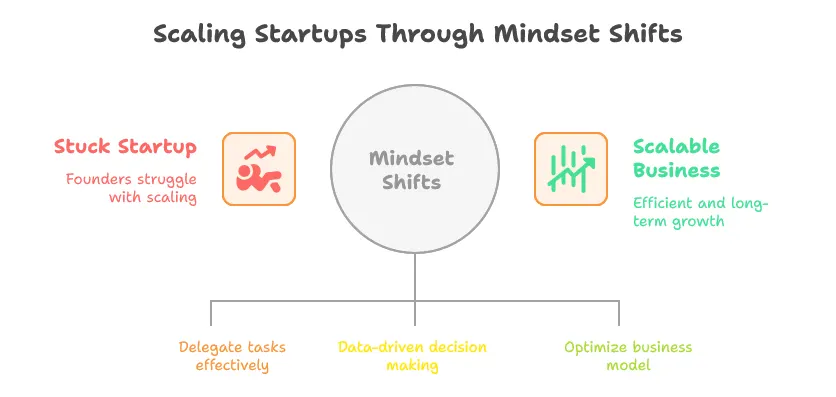Understanding the 6 Stages of a Startup’s Growth Journey

Founding a startup used to mean going solo. You’d be responsible for everything developing the product, doing the marketing, and using your personal savings to fund it all. It was a grind, with few resources and a lot of late nights. But today, it’s a whole different story. Startups now have access to tons of resources that make growing and scaling way easier.
Now, startups have access to a wide range of resources funding options, marketing tools, software for team collaboration, and customer management systems making it easier to scale and grow.
Startups typically go through six key stages: Pre-Seed, Seed, Early, Growth, Expansion, and Exit. In this blog, we'll look into each stage of a startup, covering the challenges and opportunities at every step.
Stage 1: Pre-seed – Laying the foundation
At the Pre-seed stage, you’ve just got an idea and no product yet. The main thing here is to test if the idea could work before you put in more time or money. It’s not just about figuring out if it’s a good idea it’s also about setting up the basics, like building your team, improving your concept, and getting early feedback from potential customers.
It’s super important to stay focused at this stage and not get distracted. A lot of startups fail here because they get caught up in shiny new opportunities or rush into things without properly testing their idea. Instead of jumping straight into building the product, take your time. Test your idea, learn from it, and make sure you’ve got a strong foundation before moving forward.
Stage 2: Seed stage – Building the minimum viable product (MVP)
At the Seed stage, you're testing your product with a stripped-down version to see if it actually works for your customers. You're not looking to perfect it yet, but to figure out if people find it useful.
Think of it as a trial run gathering feedback and making sure you're solving the problem in a way that people care about. This stage is about learning and adjusting, not getting everything right on the first try.
Actions to take in the seed stage:
-
Build only what’s necessary: Focus on the most important features to solve the main problem.
-
Launch quickly and improve: Release your MVP early, gather feedback, and make changes.
-
Secure initial funding: Look for early support from angel investors, crowdfunding, or other sources.
At this stage, you’ll also start refining your business model, identifying your target market, and gathering early user feedback. It's important to ensure that the MVP is scalable and that your initial users' experiences provide valuable insights into what works and what doesn’t. The goal is to learn quickly, adjust, and set the stage for future growth.
Stage 3: Early stage – Product-market fit & traction
In the Early stage, your goal is to prove that your product is more than just a good idea. Achieving product-market fit (PMF) means your product is solving a real, tangible problem for a specific group of customers, and there is genuine demand for it.
This is the stage where you start seeing early signs of traction not just in terms of sales but in customer interest, engagement, and retention. You’ve already built your MVP, but now it’s time to refine it based on real user feedback and usage patterns.
At this stage, you need to deeply understand what your users want, how they interact with your product, and where they find value. Collecting feedback through surveys, interviews, and usage data will help you identify features that need improvement and which aspects of your product are driving the most value.
The focus now shifts to validating the problem-solution fit. This is where you prove that your product not only works but also addresses the core needs of your target audience.
Once you’ve achieved PMF, the next step is scaling, but be cautious ramping up too quickly without fully understanding your users’ needs or without having proper systems in place can lead to wasted resources.
The Early stage is about understanding the key drivers behind user behaviour, refining your product, and preparing for sustainable growth.
Stage 4: Growth stage – Scaling operations
Once you’ve gained some customers, it’s time to grow your business. This is when things get more serious. You’ve found that people like your product, and now you can reach more customers, improve your business processes, and focus on growing.
At this stage, you may need to raise more money to spend on advertising, hire more people, and get tools to help your business grow faster.
Scaling comes with challenges like managing larger teams, keeping customers satisfied, and controlling costs. Expanding too fast can affect quality and distract from your core values.
Stage 5: Expansion stage – Market domination
In the Expansion stage, startups focus on reaching more customers by expanding into new markets or offering new products. This requires strategic planning to ensure sustainable growth while managing a larger, more complex organisation.
Founders often turn to mentors or experienced business owners for advice, as strong connections and guidance become crucial during this phase.
As you expand, achieving market leadership becomes vital. It's essential to stay ahead of competitors by continuously monitoring their moves and refining your strategies to maintain a competitive edge.
Stage 6: Exit stage – The final milestone
The Exit stage is the final goal for many founders. It happens when your business is sold, merged, or goes public through an IPO. This marks the end of your startup journey. Exit planning means making your business appealing to buyers or investors by ensuring it operates well and is financially strong.
For some, it’s about making money and starting new projects; for others, it’s about leaving behind something lasting.
Here are some popular exit strategies:
-
Acquisition: A bigger company buys your startup to grow its products or reach.
-
Merger: You join forces with another company to become stronger together.
-
IPO: You sell shares of your company to the public for the first time.
Each exit strategy has its own benefits and challenges. If you choose to go public with an IPO, your business will need a lot of preparation, financial checks, and legal work. If you decide to sell the company, you could make a good profit. At this point, it’s important to start planning ahead.
Startup Journey: 0 to 1 vs 1 to N, Two Growth Mindsets for Founders

The startup journey has two phases: building something from scratch (0 to 1) and scaling something that works (1 to N). Peter Thiel popularised this concept. Founders often excel in one phase but struggle with the other, which can cause a critical turning point where businesses get stuck.
Understanding these phases helps you recognise your strengths and areas where you may need extra help. The mindset that gets you to product-market fit can hold you back when it’s time to scale. This shift isn’t just about growth – it’s a complete change in how you view your business.
This blog explores the challenges of each phase in the startup journey and the mindset shifts needed to succeed.
From zero to one: Creating the unseen
The 0 to 1 phase is all about starting from scratch. The founders spot opportunities that others don't. You have to mix creative thinking with practical action to bring those ideas to life.
In the early stage, you'll need to become comfortable with uncertainty and rejection. Your idea is unproven, has no users or revenue, and is likely to be met with scepticism from others. The goal is to test quickly, make adjustments, and iterate, rather than aim for perfection or scale. You’ll usually be working with limited resources, trying out multiple directions.
To succeed in this phase, you need to recognise real problems and develop solutions that appeal to early adopters. The 0 to 1 stage is filled with frequent pivots as you refine your understanding of the market. Instead of focusing on traditional metrics like revenue, your priority is finding product-market fit.
From one to n: Scaling what works
The 1 to N phase takes a proven solution and turns it into a scalable business that can reach bigger markets. The focus moves from finding out what works to making it better. Rather than asking "Does this work?," the question changes to "How can we improve this and expand to more customers?" This shift calls for new skills and priorities.
Scaling demands structured processes to maintain quality and consistency. The flexible methods used in the 0 to 1 phase no longer work as you expand. You must create systems for hiring, management, documentation, and quality control, which may have felt unnecessary earlier.
As your startup grows, fresh challenges will emerge, calling for a new way of thinking. The focus will shift from proving your idea works to building efficiency and ensuring long-term growth. At this stage, you'll need to pay attention to hiring, operations, and how you use your capital.
Many founders find this transition hard, as it asks for skills they didn’t need when first starting out.
Top 3 mindset shifts most founders miss
The shift between startup phases requires important changes in perspective, which many founders miss. These mindset changes determine whether your business successfully grows from creation to scaling.
From generalist to specialist delegation
Founders in the early stages typically handle tasks across product development, marketing, operations, and fundraising. This generalist approach works initially but becomes unsustainable when scaling. The shift requires changing from "doing everything" to creating systems and teams that manage specialised functions more effectively.
Many founders find this transition difficult because their hands-on approach, which helped early progress, becomes a barrier to growth. Effective delegation means setting clear roles, creating accountability systems, and focusing on areas where you provide unique value. Your role changes from executor to coordinator and vision-holder.
From intuition to data-driven decision-making
Early-stage decisions often depend on the founder's intuition and market feedback because there’s limited data. As the business grows, relying on intuition alone leads to inconsistency and missed chances. You need systems to collect, analyse, and apply data to make better decisions.
Shifting to data-driven decision-making requires investing in systems to measure, analyse, and sometimes hire specialised talent. This change can feel uncomfortable at first as informal processes become more formal. Successful founders embrace this shift while still maintaining the creative thinking that helped them succeed in the beginning.
From product focus to business model optimisation
Early-stage founders often dive deep into product development and acquire initial customers. But when it’s time to scale, the focus needs to expand to optimise the whole business model, including pricing, distribution channels, and customer acquisition costs. This shift in perspective takes you from building a product to creating a business that lasts.
Many founders miss this shift because they concentrate on product innovation rather than business operations. The change requires developing expertise or hiring team members with it in areas that may seem less exciting than product development. Your view of value creation changes from "what we build" to "how we deliver, monetise, and scale what we build."
Case study: Founder who shifted gears right
Deepinder Goyal’s journey with Zomato is a perfect example of how to handle both the 0 to 1 and 1 to N phases. It started with a basic idea – diners just wanted an easy way to look at restaurant menus online. This small, simple insight revealed a real market need that traditional methods weren’t fulfilling.
At first, he tried to solve the problem of both diners and restaurants. The first version of the product was simple digitised menus and basic restaurant information. This phase was about constant refinement based on what users said, rather than perfecting complex features. The focus was always on solving a specific problem for a clear user group.
The transition to the 1-to-N phase showed Goyal’s ability to adapt. He realised that scaling needed different approaches and built teams, processes, and funding structures to support growth. This involved delegating operations to specialised teams while keeping strategic control.
The company evolved from a menu aggregator to a full-service food delivery platform through systematic growth.
The full journey: From zero to one, then one to many
The startup journey is about recognising the phase you’re in and adjusting your approach accordingly and strategically. Each stage builds on the last, requiring different skills and mindsets. Getting acquainted with these differences helps you make smoother transitions and create the right teams and processes for each phase.
Strong founders have a good understanding of their strengths at each phase of the journey. Some founders excel in the creative chaos of 0 to 1 but find it difficult to handle the operational demands of scaling. Others are fantastic at scaling but miss out on recognising new opportunities.
Being aware of their strengths and weaknesses helps them know when to reach out to talent or advisors to fill the gaps. Successful ventures usually have founding teams with complementary strengths in both phases.
If you're working alone, building relationships with mentors and advisors who have navigated both phases can offer essential guidance during critical points in your startup journey.
How GrowthJockey can help startups at every stage
GrowthJockey as a venture builder helps startups at every stage of their growth with smart advice and solutions. Whether you’re just starting out and looking for feedback or you’re ready to grow, we provide expert support.
Our team helps you improve how things work, get funding, and reach more people. We guide you smoothly from your first product to becoming a market leader. Work with us to make your startup journey successful.
FAQs
1. What are the stages of a startup?
It includes Pre-seed, Seed, Early, Growth, Expansion, and Exit. Each level has different goals, from testing your idea to growing and planning your next move.
2. What is the lifecycle of a startup?
The lifecycle is the journey from idea to success. It begins with planning, then moves through growth and expansion, and ends with either selling or becoming a stable business.
3. What is the MVP stage of a startup?
The MVP stage is when you build a simple version of your product to test interest and get feedback to make it better.








